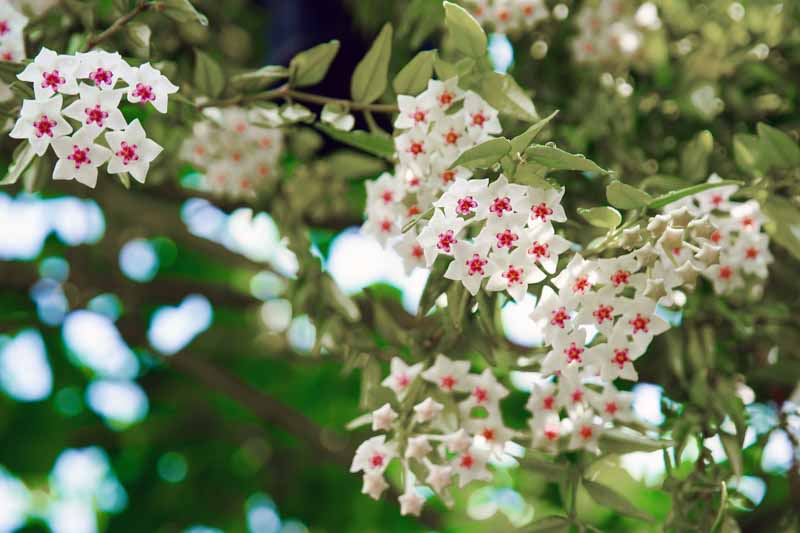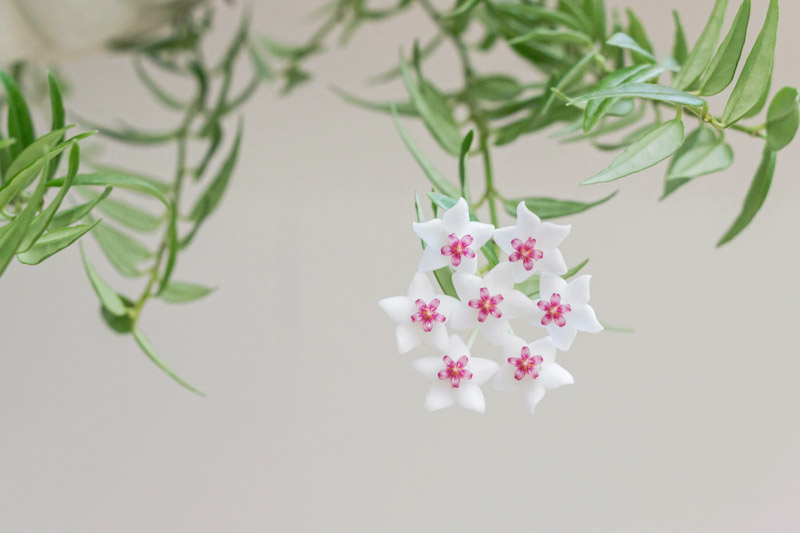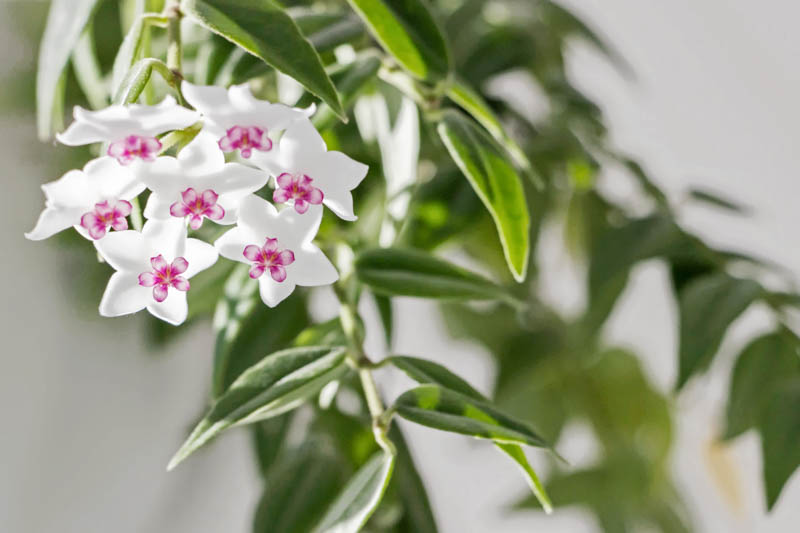Beautiful Hoya, Waxflower, Pretty Waxflower, Miniature Wax Plant, Hoya lanceolata subsp. bella
Hoya bella, also known as the Beautiful Wax Plant, is renowned for its delicate, cascading vines adorned with small, lanceolate, glossy green leaves. This charming species captivates with its dainty appearance and profusion of white, star-shaped flowers that have a central pink or red crown, exuding a subtle, sweet fragrance.
Hoya bella is a charming, small-sized Hoya with cascading vines adorned with lance-shaped, glossy green leaves. It blooms profusely with clusters of white, star-shaped flowers surrounded by a pinkish-purple corona, emitting a delicate fragrance.
Native: Native to the tropical rainforests of Southeast Asia, particularly India, Thailand, and Burma, Hoya bella thrives in warm, humid environments; replicating these conditions at home can help it flourish. It belongs to the dogbane family (Apocynaceae), along with plumeria, periwinkle, mandevilla, or oleander.
Plant Type and Habit: Hoya bella is a tropical epiphyte (growing on trees) shrub with a trailing habit, making it perfect for hanging baskets where its beautiful foliage and flowers can cascade gracefully.
Size: Indoors, its vines can extend to about 12-18 inches in length (30-45 cm), making it a manageable and sizeable indoor plant.
Hoya Flower: It blooms in the warmer months, producing clusters of petite, star-shaped flowers that last several weeks. The blooms not only add aesthetic value but also attract attention with their delicate beauty and fragrance.
Fruit: Like other Hoyas, it can produce seed pods after successful pollination, though this is less common indoors.
Foliage: Its small, fleshy, lance-shaped leaves are tightly packed along the stems, contributing to its lush, green appearance year-round.
Hardiness: If grown outdoors, it’s best suited for USDA zones 11-12; indoors, it’s remarkably adaptable across a wide range of temperatures typical of household environments.
Award: Recipient of the prestigious Award of Garden Merit of the Royal Horticultural Society.
Uses: Ideal as a decorative houseplant, Hoya bella enhances indoor spaces with its verdant foliage and striking blooms. It’s suited for living areas, kitchens, bathrooms, and offices, especially when placed in hanging baskets or on high shelves.
Toxicity: Hoya bella is non-toxic to pets and humans, making it a safe addition to households with animals and children.
Invasiveness: It is not considered invasive, as it’s mostly grown in controlled indoor or greenhouse environments.
Benefits: Beyond its ornamental appeal, Hoya bella is believed to contribute to indoor air purification by absorbing pollutants, though this benefit is generally modest compared to its visual and aromatic contributions.

Growing and caring for Hoya bella is straightforward, making it an ideal choice for both novice and experienced plant enthusiasts.
Light: Hoya bella thrives in bright, indirect light. Too much direct sunlight can scorch its leaves, while too little light may inhibit flowering. An east or west-facing window covered with a sheer curtain is ideal.
Soil: Use a well-draining potting mix, ideally one that contains perlite or orchid bark, to ensure excess water can escape easily.
Water: Water Hoya bella when the top inch of the soil feels dry to the touch. Reduce watering in the winter months. Overwatering can lead to root rot, so ensure good drainage.
Temperature and Humidity: Hoya bella enjoys warm conditions, ideally between 60°F to 80°F (15°C to 27°C). Protect it from drafts and sudden temperature changes to prevent stress. This plant prefers higher humidity levels, similar to its native tropical environment. Regular misting, a pebble tray with water, or a humidifier can help meet its humidity needs.
Fertilization: Fertilize during the growing season (spring to summer) with a diluted, balanced houseplant fertilizer every 4 to 6 weeks to encourage growth and flowering.
Pruning: Trimming is seldom necessary, but you can prune your Hoya bella to shape it or remove any unhealthy growth. Pruning after blooming encourages new growth and more blooms.
Repotting: Repot every 2 to 3 years or when the plant becomes root-bound. Use a slightly larger pot to encourage continued growth.

Propagating Hoya bella can be a rewarding experience, allowing you to expand your collection or share with friends. The most effective method is stem cuttings. Here’s how:
Select a Healthy Stem: Choose a healthy stem with at least 2-3 leaves and a node (the point on the stem where leaves emerge). Cuttings should be about 4-6 inches long.
Cut: Using a clean, sharp pair of scissors or pruning shears, make a cut just below a node. This area is where the roots will emerge.
Rooting Medium:
Location: Place the cutting in a warm spot with bright, indirect light. Avoid direct sunlight, which can scorch the cutting.
Transplanting: Once the roots have developed and are a few inches long (for water rooting) or the cutting has established in the soil (usually after a few weeks to a month), you can transplant the cutting into its permanent pot.
Aftercare: Treat the new Hoya bella plant as you would a mature one, focusing on providing bright, indirect light, maintaining humidity, and watering when the top inch of soil dries out.

Hoya bella is generally resilient, but like all plants, it may encounter pests and diseases.
Mealybugs: Look for white, cottony masses on stems and undersides of leaves. Remove with alcohol-dipped cotton swabs or apply insecticidal soap.
Scale insects: Hard, dome-shaped pests that attach firmly to stems and leaves, feeding on sap. Their presence can lead to yellowing leaves, stunted growth, and a decline in plant health.
Spider mites: Cause yellowing leaves and fine webs. Increase humidity and treat with miticide or insecticidal soap.
Root rot: Caused by overwatering and poor drainage. Ensure well-draining soil and allow the topsoil to dry out between waterings.
Yellowing Leaves: Over-watering or poor drainage can lead to yellow leaves. Adjust your watering schedule and ensure the pot has adequate drainage.
Leaf Drop: Sudden changes in temperature, light, or watering habits can stress the plant, causing leaves to drop. Keep environmental conditions as stable as possible.
Lack of Flowers: Hoya bella needs bright, indirect light to bloom. If it’s not flowering, consider moving it to a brighter spot.
Slow Growth: This could be due to inadequate light, the pot being too large, or the need for fertilization. Provide bright, indirect light and feed with a balanced liquid fertilizer during the growing season.
Yes, Hoya bella is considered easy to care for, making it a suitable choice for both beginner and experienced plant enthusiasts. It thrives in bright, indirect light and requires only moderate watering, making its maintenance relatively straightforward.
Hoya bella is popularly grown as a houseplant due to its compact size and beautiful, cascading growth habit. Its ability to adapt to indoor environments, alongside its striking appearance, makes it an excellent choice for adding a touch of nature to home interiors.
Hoyas, including Hoya bella, are often associated with love, protection, and spiritual growth. Their star-shaped flowers can symbolize celestial beauty and guidance, making them meaningful gifts to express care and affection.
To encourage Hoya bella to bloom, follow these tips:
| Hardiness |
11 - 12 |
|---|---|
| Plant Type | Houseplants, Climbers |
| Plant Family | Apocynaceae |
| Genus | Hoya |
| Exposure | Partial Sun |
| Season of Interest |
Spring (Early, Mid, Late) Summer (Early, Mid, Late) Fall Winter |
| Height |
1' - 2' (30cm - 60cm) |
| Spread |
1' - 2' (30cm - 60cm) |
| Maintenance | Low |
| Water Needs | Average |
| Soil Type | Loam, Sand |
| Soil pH | Acid, Alkaline, Neutral |
| Soil Drainage | Well-Drained |
| Characteristics | Plant of Merit, Showy, Evergreen, Fragrant |
| Garden Uses | Hanging Baskets, Patio And Containers |
| Garden Styles | Mediterranean Garden |
| Hardiness |
11 - 12 |
|---|---|
| Plant Type | Houseplants, Climbers |
| Plant Family | Apocynaceae |
| Genus | Hoya |
| Exposure | Partial Sun |
| Season of Interest |
Spring (Early, Mid, Late) Summer (Early, Mid, Late) Fall Winter |
| Height |
1' - 2' (30cm - 60cm) |
| Spread |
1' - 2' (30cm - 60cm) |
| Maintenance | Low |
| Water Needs | Average |
| Soil Type | Loam, Sand |
| Soil pH | Acid, Alkaline, Neutral |
| Soil Drainage | Well-Drained |
| Characteristics | Plant of Merit, Showy, Evergreen, Fragrant |
| Garden Uses | Hanging Baskets, Patio And Containers |
| Garden Styles | Mediterranean Garden |
How many Hoya bella (Beautiful Wax Plant) do I need for my garden?
| Plant | Quantity | |
|---|---|---|
| Hoya bella (Beautiful Wax Plant) | N/A | Buy Plants |
Create a membership account to save your garden designs and to view them on any device.
Becoming a contributing member of Gardenia is easy and can be done in just a few minutes. If you provide us with your name, email address and the payment of a modest $25 annual membership fee, you will become a full member, enabling you to design and save up to 25 of your garden design ideas.
Join now and start creating your dream garden!
Create a membership account to save your garden designs and to view them on any device.
Becoming a contributing member of Gardenia is easy and can be done in just a few minutes. If you provide us with your name, email address and the payment of a modest $25 annual membership fee, you will become a full member, enabling you to design and save up to 25 of your garden design ideas.
Join now and start creating your dream garden!